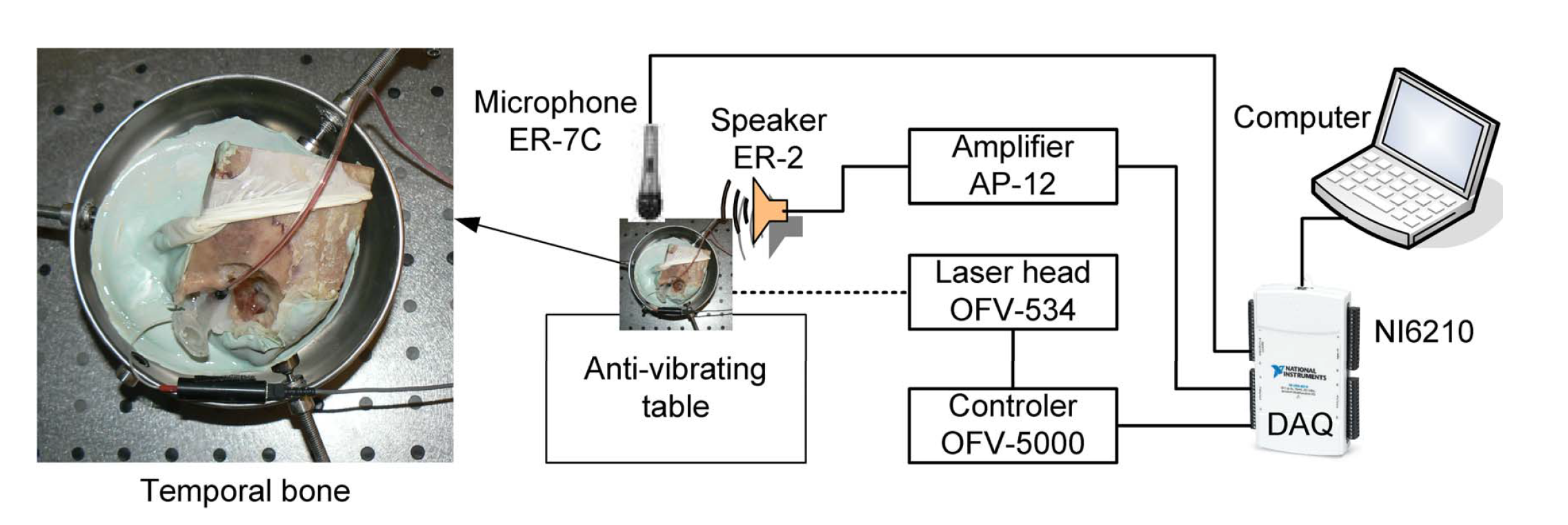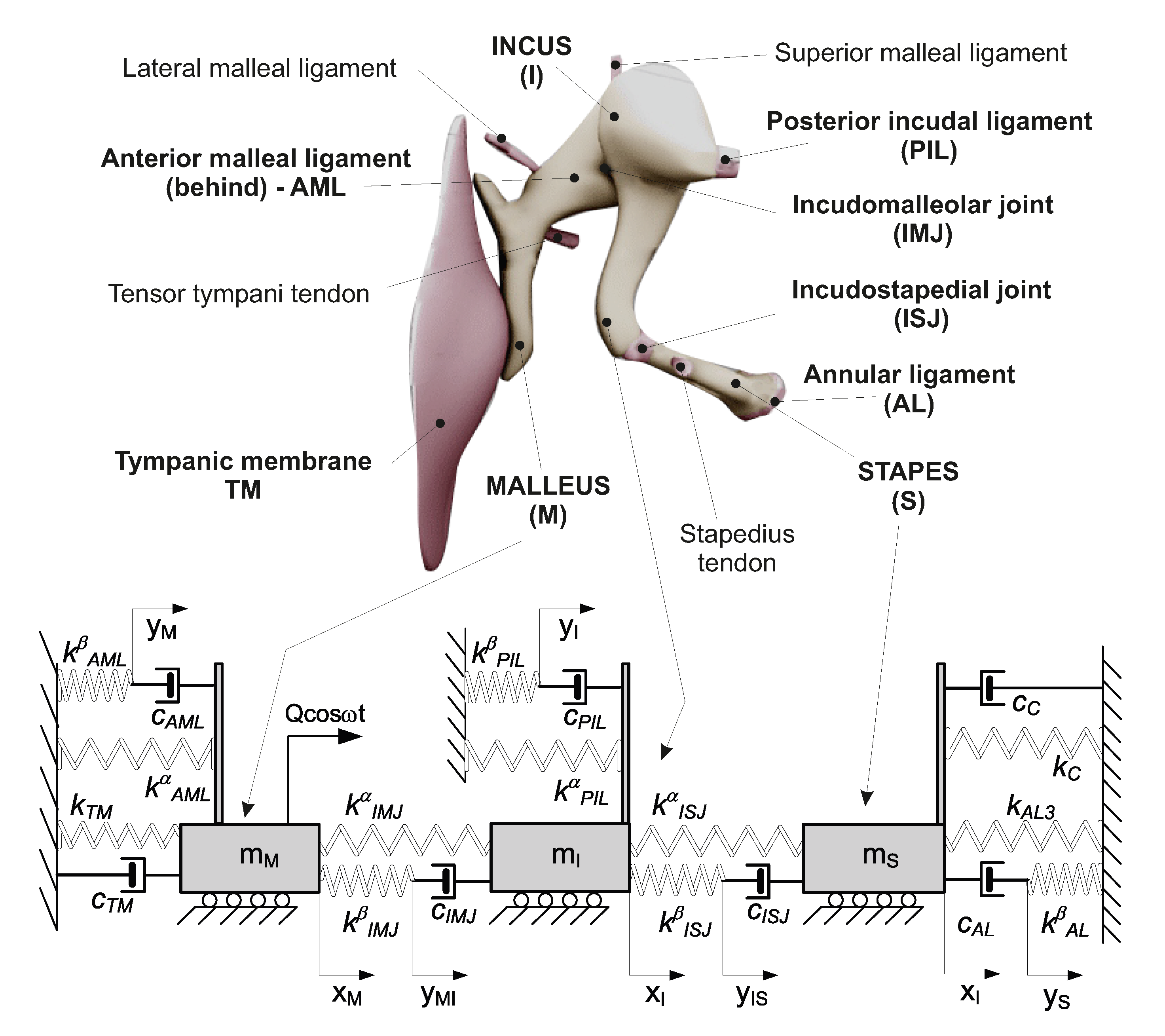Biomechanics of the Human Middle Ear with Viscoelasticity of the Maxwell and the Kelvin–Voigt Type and Relaxation Effect
Abstract
:1. Introduction
2. Materials and Methods
2.1. Experimental Procedure
2.2. Middle Ear Models
- Model 1—Maxwell viscoelasticity
- Model 2—Kelvin–Voigt viscoelasticity
- Model 3—Kelvin–Voigt viscoelasticity with relaxation
2.3. Numerical Procedure
3. Results
3.1. Frequency Response Function
3.2. Influence of Excitation Amplitude
3.3. Effect of Stiffness Ratio
3.4. Effect of Relaxation Time
4. Discussion
5. Conclusions
- two main resonances of the middle ear are observed in the experiment on the human temporal bones;
- experimental tests, performed to track the parameters and to test the mathematical models outputs, prove that the models give consistent results with experimental outcomes for the tested preliminary parameters;
- the middle ear models with the Maxwell and the K-V viscoelasticity yield very similar results, particularly when the relaxation time is short and the excitation amplitude is small;
- a longer relaxation time causes an offset of the second resonance in the human middle ear;
- the effect of disturbed harmonic response (DHR) occurs at slightly different values of external excitation in the model with the Maxwell viscoelasticity, when compared to the Kelvin–Voigt model;
- the analysed ME model of the Maxwell type of viscoelasticity is sensitive for the stiffness ratio () which changes the value of the resonance amplitude.
Author Contributions
Funding
Acknowledgments
Conflicts of Interest
Abbreviations
| FEM | Finite Element Method |
| K-V | Kelvin–Voigt |
| ME | middle ear |
| FRF | frequency response function |
| DHR | disturbed harmonic response |
Appendix A. Model 1
Appendix B. Model 2
References
- Moller, A.R. Network Model of the Middle Ear. J. Acoust. Soc. Am. 1961, 33, 168–176. [Google Scholar] [CrossRef]
- Zwislocki, J. Analysis of the Middle-Ear Function. Part I: Input Impedance. J. Acoust. Soc. Am. 1962, 34, 1514–1523. [Google Scholar] [CrossRef] [Green Version]
- Voss, S.E.; Rosowski, J.J.; Merchant, S.N.; Peake, W.T. Acoustic responses of the human middle ear. Hear. Res. 2000, 150, 43–69. [Google Scholar] [CrossRef]
- Ravicz, M.E.; Peake, W.T.; Nakajima, H.H.; Merchant, S.N.; Rosowski, J.J. Modeling Flexibility in the Human Ossicular Chain: Comparision to Ossicular Fixation Data. In Middle Ear Mechanics in Research and Otology; Gyo, K., Wada, H., Eds.; Word Scientific: Singapore, 2004. [Google Scholar]
- Nakajima, H.H.; Ravicz, M.E.; Merchant, S.N.; Peake, W.T.; Rosowski, J.J. Experimental ossicular fixations and the middle ears response to sound: Evidence for a flexible ossicular chain. Hear. Res. 2005, 204, 60–77. [Google Scholar] [CrossRef]
- Feng, B.; Gan, R.Z. A lumped-parameter mechanical model of human ear for sound transmission. In Proceedings of the Second Joint Embs-Bmes Conference 2002, Houston, TX, USA, 23–26 October 2002; pp. 267–268. [Google Scholar]
- Sopakayang, R. Viscoelastic Models for Ligaments and Tendons. Ph.D. Thesis, Virginia Polytechnic Institute and State University, Blacksburg, VA, USA, 2010. [Google Scholar]
- Thornton, G.M.; Oliynyk, A.; Frank, C.B.; Shrive, N.G. Ligament creep cannot be predicted from stress relaxation at low stress: A biomechanical study of the rabbit medial collateral ligament. J. Orthop. Res. 1997, 15, 652–656. [Google Scholar] [CrossRef]
- Provenzano, P.; Lakes, R.; Keenan, T.; Vanderby, R.J. Nonlinear Ligament Viscoelasticity. Ann. Biomed. Eng. 2001, 29, 908–914. [Google Scholar] [CrossRef]
- Hingorani, R.V.; Provenzano, P.P.; Lakes, R.S.; Escarcega, A.; Vanderby, R. Nonlinear Viscoelasticity in Rabbit Medial Collateral Ligament. Ann. Biomed. Eng. 2004, 32, 306–312. [Google Scholar] [CrossRef]
- Ciarletta, P.; Micera, S.; Accoto, D.; Dario, P. A novel microstructural approach in tendon viscoelastic modelling at the fibrillar level. J. Biomech. 2006, 39, 2034–2042. [Google Scholar] [CrossRef]
- Lauxmann, M.; Eiber, A.; Haag, F.; Ihrle, S. Nonlinear stiffness characteristics of the annular ligament. J. Acoust. Soc. Am. 2014, 136, 1756–1767. [Google Scholar] [CrossRef] [Green Version]
- Ihrle, S.; Lauxmann, M.; Eiber, A.; Eberhard, P. Nonlinear modelling of the middle ear as an elastic multibody system—Applying model order reduction to acousto-structural coupled systems. J. Comput. Appl. Math. 2013, 246, 18–26. [Google Scholar] [CrossRef]
- Rusinek, R. Sound Transmission in the First Nonlinear Model of Middle Ear with an Active Implant. Math. Probl. Eng. 2020, 2020, 4580467. [Google Scholar] [CrossRef]
- Rusinek, R.; Weremczuk, A.; Szymanski, M.; Warminski, J. Middle ear vibration with stiff and flexible shape memory prosthesis. Int. J. Mech. Sci. 2019, 150, 20–28. [Google Scholar] [CrossRef]
- Rusinek, R.; Warminski, J.; Szymanski, M.; Kecik, K.; Kozik, K. Dynamics of the middle ear ossicles with an SMA prosthesis. Int. J. Mech. Sci. 2017, 127, 163–175. [Google Scholar] [CrossRef]
- Cheng, T.; Gan, R.Z. Mechanical properties of anterior malleolar ligament from experimental measurement and material modeling analysis. Biomech. Model. Mechanobiol. 2008, 7, 387–394. [Google Scholar] [CrossRef]
- Gan, R.Z.; Yang, F.; Zhang, X.; Nakmali, D. Mechanical properties of stapedial annular ligament. Med Eng. Phys. 2011, 33, 330–339. [Google Scholar] [CrossRef] [Green Version]
- Cheng, T.; Gan, R.Z. Experimental measurement and modeling analysis on mechanical properties of tensor tympani tendon. Med Eng. Phys. 2008, 30, 358–366. [Google Scholar] [CrossRef]
- Cheng, T.; Gan, R.Z. Mechanical properties of stapedial tendon in human middle ear. J. Biomech. Eng. 2007, 129, 913–918. [Google Scholar] [CrossRef]
- Rusinek, R.; Szymanski, M.; Warminski, J.; Zadrozniak, M.; Morshed, K. Vibrations in the Human Middle Ear. Med Sci. Monit. 2011, 17, 372–376. [Google Scholar] [CrossRef] [Green Version]
- Rusinek, R.; Szymanski, M.; Lajmert, P. Vibration of middle ear with shape memory prosthesis—Experimental and numerical study. AIP Conf. Proc. 2018, 1922, 120013. [Google Scholar] [CrossRef]
- Fratzl, P. Collagen: Structure and Mechanics; Springer: New York, NY, USA, 2008. [Google Scholar]
- Pust, L.; Peterka, F.; Stepan, G.; Tomlinson, G.R.; Tondl, A. Nonlinear oscillations in machines and mechanisms theory. Mech. Mach. Theory 1999, 34, 1237–1253. [Google Scholar] [CrossRef]
- Viidik, A. A rheological model for uncalcied parallel-bred collagenous tissue. J. Biomech. 1967, 1, 3–11. [Google Scholar] [CrossRef]
- Dai, C.; Cheng, T.; Wood, M.W.; Gan, R.Z. Fixation and detachment of superior and anterior malleolar ligaments in human middle ear: Experiment and modeling. Hear. Res. 2007, 230, 24–33. [Google Scholar] [CrossRef] [Green Version]
- Eiber, A.; Freitag, H.G.; Burkhardt, C.; Hemmert, W.; Maassen, M.; Rodriguez Jorge, J.; Zenner, H.P. Dynamics of Middle Ear Prostheses—Simulations and Measurements. Audiol. Neurootol. 1999, 4, 178–184. [Google Scholar] [CrossRef]
- Gan, R.Z.; Sun, Q. Finite element modeling of human ear with external ear canal and middle ear cavity. In Proceedings of the Second Joint Embs-Bmes Conference 2002, Houston, TX, USA, 23–26 October 2002; pp. 264–265. [Google Scholar]
- Sun, Q.; Gan, R.Z.; Chang, K.H.; Dormer, K.J. Computer-integrated finite element modeling of human middle ear. Biomech. Model. Mechanobiol. 2002, 1, 109–122. [Google Scholar] [CrossRef]
- Taschke, H.; Weistenhofer, C.; Hudde, H. A full-size physical model of the human middle ear. Acustica 2000, 86, 103–116. [Google Scholar]
- Ravicz, M.E.; Rosowski, J.J.; Merchant, S.N. Mechanisms of hearing loss resulting from middle-ear fluid. Hear. Res. 2004, 195, 103–130. [Google Scholar] [CrossRef]
- Davis, F.M.; Vita, R.D. A Nonlinear Constitutive Model for Stress Relaxation in Ligaments and Tendons. Ann. Biomed. Eng. 2012, 40, 2541–2550. [Google Scholar] [CrossRef]
- Davis, F.M.; Vita, R.D. A three-dimensional constitutive model for the stress relaxation of articular ligaments. Biomech. Model. Mechanobiol. 2014, 13, 653–663. [Google Scholar] [CrossRef]
- Duenwald, S.E.; Vanderby, R.; Lakes, R.S. Stress relaxation and recovery in tendon and ligament: Experiment and modeling. Biorheology 2010, 47, 1–14. [Google Scholar] [CrossRef]
- Szymanski, M.; Mills, R. Movements of the ossicular chain during changes in static pressure. Otolaryngol. Polska. Pol. Otolaryngol. 2004, 58, 593–597. [Google Scholar]










| Model 1 | Model 2 | Model 3 |
|---|---|---|
| Maxwell viscoelasticity | Kelvin–Voigt viscoelasticity | Kelvin–Voigt viscoelasticity with relaxation effect |
| Figure 2 | Figure 3 | Figure 3 |
| Equations (7) and (A5) | Equations (8) and (A10) | Equations (9) and (10) |
| Stiffness | Damping | Damping | Other |
|---|---|---|---|
| (Model 1,2,3) | Maxwell (Model 1) | Kelvin–Voigt (Model 2,3) | |
| mN/m | = 378 mNs/mm | = 60 mNs/mm | = 25 mg |
| mN/m | = 0.4 mNs/mm | = 275 mNs/mm | = 28 mg |
| mN/m | = 359 mNs/mm | = 359 mNs/mm | = 1.78 mg |
| mN/m | = 55 mNs/mm | = 55 mNs/mm | N |
| mN/m | = 7.9 mNs/mm | = 7.9 mNs/mm | |
| mN/m | = 4000 mNs/mm | = 2 mNs/mm | |
| mN/m | = 11 mNs/mm | = 1.7 mNs/mm | |
| mN/m | |||
| mN/m |
© 2020 by the authors. Licensee MDPI, Basel, Switzerland. This article is an open access article distributed under the terms and conditions of the Creative Commons Attribution (CC BY) license (http://creativecommons.org/licenses/by/4.0/).
Share and Cite
Rusinek, R.; Szymanski, M.; Zablotni, R. Biomechanics of the Human Middle Ear with Viscoelasticity of the Maxwell and the Kelvin–Voigt Type and Relaxation Effect. Materials 2020, 13, 3779. https://doi.org/10.3390/ma13173779
Rusinek R, Szymanski M, Zablotni R. Biomechanics of the Human Middle Ear with Viscoelasticity of the Maxwell and the Kelvin–Voigt Type and Relaxation Effect. Materials. 2020; 13(17):3779. https://doi.org/10.3390/ma13173779
Chicago/Turabian StyleRusinek, Rafal, Marcin Szymanski, and Robert Zablotni. 2020. "Biomechanics of the Human Middle Ear with Viscoelasticity of the Maxwell and the Kelvin–Voigt Type and Relaxation Effect" Materials 13, no. 17: 3779. https://doi.org/10.3390/ma13173779
APA StyleRusinek, R., Szymanski, M., & Zablotni, R. (2020). Biomechanics of the Human Middle Ear with Viscoelasticity of the Maxwell and the Kelvin–Voigt Type and Relaxation Effect. Materials, 13(17), 3779. https://doi.org/10.3390/ma13173779






